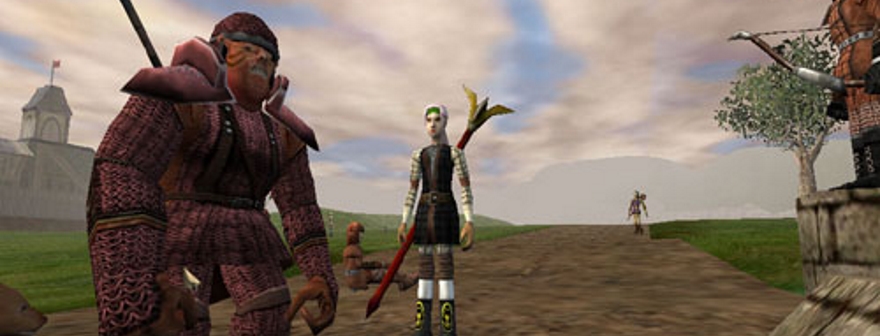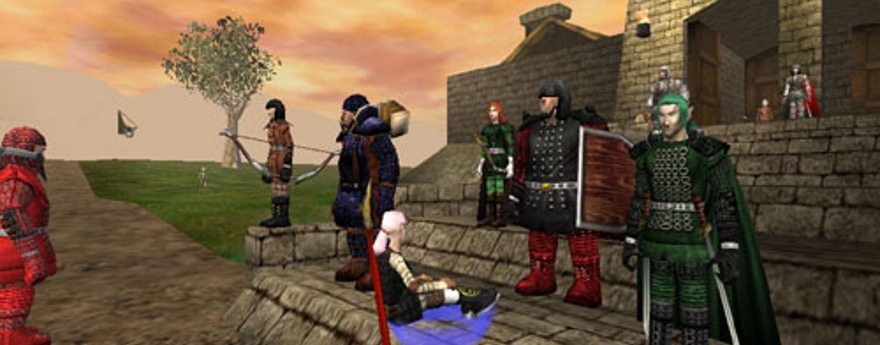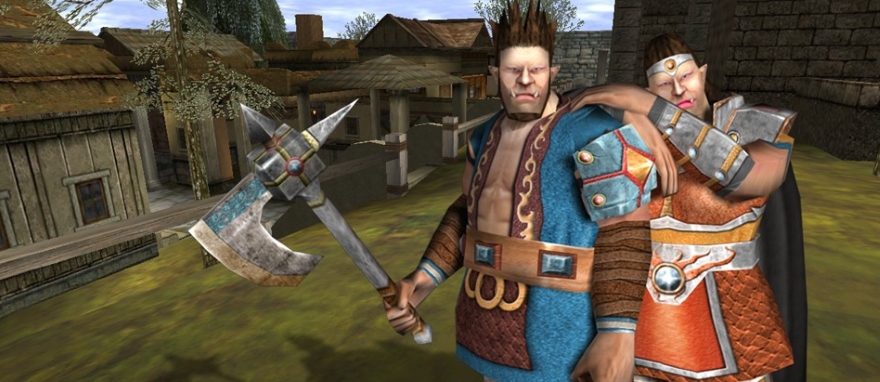
I can’t say that Rubies of Eventide has been on my radar, like, ever. And yet practically every time I’ve asked for suggestions of a game to cover in this column, it seems like someone pipes up asking that Rubies gets a little publicity. That tells me that there’s some underground love for this title.
There are two things that separate Rubies of Eventide from the rest of the MMO pack and make it a fascinating case study. The first is that it’s one of the very few MUDs that was transformed into a graphical MMO while retaining its roots in old-school play. The second is that it had an absolutely ridiculous number of playable classes — 104, to be precise. Some days I really miss the era when game designers would aspire to reach these incredible numbers.
Faced with the prospect of an early death, Rubies of Eventide miraculously survived and ran for six interesting years. Let’s take a look at a MUD-turned-MMO this week, shall we?
Wallowing in the MUD
We’ve talked several times about how MUDs helped to spur the creation of many early graphical MMOs like EverQuest, but Rubies of Eventide was a rare case of a MUD “graduating” directly to this next level. An old-school MUD from 1998, Rubies of Eventide was created and supported by studio Cyber Warrior. It was so old, in fact, that it even had a working DOS client.
Witnessing the incredible popularity of graphical MMOs like Ultima Online, Cyber Warrior decided to give Rubies a face to go with its personality. The team created a graphical client that was powered by Lithtech’s Jupiter engine while retaining the game’s MUD roots. In so doing, Rubies of Eventide became an ambassador between the old generation and the new.
Product Manager Julia Howe explained the blending as such: “The design of Rubies of Eventide combines the traditional and the cutting edge. While it improves upon and refines many of the shortcomings of competing titles, it also has a classic MUD feel and flavor to it.”
Rise, Rubies, Rise
When it launched as a graphical MMO in June 2003, Rubies of Eventide had all of the odds against it from the start. Players were reaping the benefits of much more modern-feeling MMOs and quickly forgetting the days of MUDs. There was a lot more competition in the field, too, and even more to come.
Cyber Warrior tried to overcome these handicaps by offering a free 10-day trial before players would be asked to pony up dough. That wasn’t enough, however, and Rubies of Eventide immediately began to flounder and capsize. By early 2004, the studio said that the game’s playerbase had declined to a mere 806 customers, not enough to sustain RoE’s operation. There was nothing left to be done; on Valentine’s Day 2004, the servers were closed.
Howe noted how long-time players of the MUD and graphical version were distraught over seeing their game world die. “We noticed from casual conversation that people kept comparing other games they were playing to RoE and never quite being satisfied with the selection out there. Being as RoE has been around for over 10 years in various incarnations, players were still very much attached to the game and missed it so much we’d get personal phone calls at odd hours.”
Usually, that would be the end of our tale. In this case, however, it was just the beginning. Unwilling to let Rubies of Eventide go, game developers Julia Howe and Jeff Grubb started a private server to keep the adventures going. The server didn’t stay private long; fans discovered it and joined in with the fun. The population swelled to a point where the devs realized that they could probably get the game to run on fan support alone.
And so it was in August 2004 that Mnemosyne, LLC. came into being, and with it the relaunch of Rubies of Eventide. Though the game required a fee in 2003, players could now play the game for free. To help fund the cost of operation and development, the devs relied instead on donations and creative contributions by the community.
“Essentially, this model helps create a more responsible gaming environment where players can take pride in the community they belong to,” said Howe in 2004. “We listened to what our customer base was asking us to provide and discovered that it was much more cost-effective to tap into the skills of our players than to do everything in-house. This means we can create more content value for less and make available an excellent venue for our players to showcase their talents to the gaming community.”
A turn-based MMO? What is this madness?
One of the reasons Rubies of Eventide fans were so darn passionate about the game is that it held to a complex structure that refused to dumb things down for the masses. For starters it boasted over a hundred classes, some of which weren’t even combat-related (such as tailors, political sycophants, and linguists). With seven races and a free-form selection of 50 skills to choose from, the freedom to sculpt your character into a decidedly unique creation was there in a way that most MMOs lacked.
“Rubies is really aiming for players who would like a more cognitively challenging game rather than mind-numbing cybercrack,” explained Howe.
Even more strange for a modern MMO but quite common for MUDs was the focus on a pseudo-turn-based combat system. Players going into combat would be asked not to act on reflexes but to take a few seconds to decide on the next course of action. It wasn’t purely turn-based, as the pause between rounds was timed, but it was enough that it definitely felt different.
The combat was also interesting in that players had blood points and spirit points in addition to hit points. Different attacks and weapons affected different pools of points, but if any of the pools dipped to zero, you died.
Rubies of Eventide wasn’t exactly the best-looking game, even by 2003 MMO standards. The models and textures were blocky, and player characters never won any beauty contests outside of their own realm. It did, oddly enough, appeal to a higher ratio of women gamers than other contemporary MMOs, possibly because the devs deliberately kept things “modest.”
“If you play this game with your daughter, [she isn’t] going to come into the game looking like some sort of swimsuit bimbo,” said Howe in an early interview. “I’m sorry if you were hoping for more sexy fantasy babes… you won’t see them here. However, if its any consolation, our male to female ratio is a strong three-to-one ratio so there is a higher likelihood that you are talking to real women.”
As the reborn game grew over time, it branched out into a trio of servers, each with its own focus (such as open-world PvP). PvP or no, eventually all players would have to deal with the grim prospect of death and how Rubies of Eventide dealt with it.
When you died, you had two options. The first was if a good friend was nearby and willing to bring your bloated corpse back to a temple and pay for a rez. The second was to rez at the temple and leave all of your inventory out on the field, retrievable for just five minutes before vanishing. Both of these also came with random death effects, such as XP or stat loss.
Riding below the radar
Even with its rebirth and free-to-play model, Rubies of Eventide remained a very niche title for the remainder of its six-year run. It never suffered from crushed servers and an overflow of population. In his review of the game during an unspecified time in the 2000s, GameOgre noted that the main server had just 36 players on it — hardly “massively” at all.
Mnemosyne branched out a little by producing a lolcats card game and a soda that is infamous for its embrace of anime rape (Tentacle Grape). Guess the modesty of the game had to be overcome somehow, eh?
The company’s interest in running Rubies of Eventide waned, and in April 2009, Mnemosyne gave the game back to Marc Howe, the original founder of the game. Howe closed the PvP server almost immediately and then shut down the remaining server in July.
It was left to Jeff Grubb to make the farewell announcement. “I am sorry to be the one who has to do this, but unfortunately nobody else is around to make an official announcement,” Grubb posted. “Rubies of Eventide is closing. I thank you for all of your support, good spirits, and most of all for being with us through the thick of it. Again, I am sorry we have to do this. We waited until the very last minute trying to find a way out of our crisis, but with the server population lower than it has ever been, there is no way around it.”
And unlike the first time that Rubies of Eventide was given a pink slip, this time it remained out of operation for good. Still, six years of a graphical MUD running in the mid-2000s is an impressive achievement when you think about it, and for some, Rubies was the wide-open online adventure that they always wanted and still do.
 Believe it or not, MMOs did exist prior to World of Warcraft! Every two weeks, The Game Archaeologist looks back at classic online games and their history to learn a thing or two about where the industry came from… and where it might be heading.
Believe it or not, MMOs did exist prior to World of Warcraft! Every two weeks, The Game Archaeologist looks back at classic online games and their history to learn a thing or two about where the industry came from… and where it might be heading.















